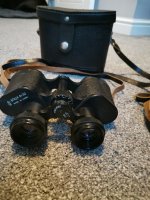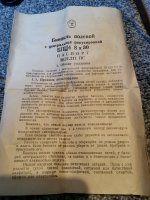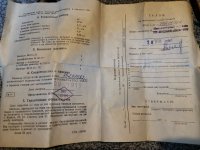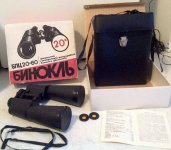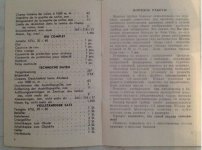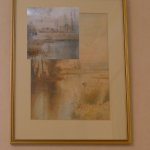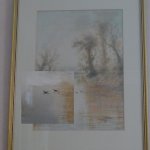Sharpness and sharpness impression, details and contrast
First, let's imagine a cat in close proximity. The cat ruffles its fur. The "edges" of the cat's body appear washed out, somewhat unsharp, out of focus, due to the visibly ruffled hair. Now we imagine the same cat at a much greater distance, no detail of the hair is visible. The cat's body appears sharp. Are we really judging the sharpness of binoculars correctly?
A short part from the German Wikipedia to shapness in photography:
"The subjective impression of sharpness[edit | edit source].
This sharpness assessment dominates our daily viewing habit. Depending on the specific circumstances (media resolution, image size, viewing distance and time, image message and own expectation) an individual sharpness measure is created.
Example:
...
Sharpness pattern 4: In the center, two versions of a face can be seen. Most viewers describe the right photo as sharper (because it has more contrast).
In the enlargements (outside), it is clear that the left image contains more sharpness. Sharpness and impression of sharpness are two different things.
This kind of sharpness assessment is influenced by a great many subjective things - hence the name subjective sharpness impression."
Sharpness pattern 4: https://de.wikipedia.org/wiki/Schärfe_(Fotografie)#/media/Datei:Schärfemuster4.jpg
Which eye has more "hairs", which eye is sharper? Our impressions (or errors) in somewhat greater distance?
Link with "sharp" pictures and short text in English:
How often are strong contrasts mistaken for excellent sharpness? Strong contrasts are often the enemy of details. Have fun thinking about why low magnification (6x, 7x) binoculars are often perceived to be "very sharp". But sharper (more details) than those with higher magnification?
And good luck for generally valid results within the further discussion whether the Nikon Monarch HG (> 800 Euro/dollars bins) is sharp or not, especially with consideration of the fact that most aberrations occur at the edge of the field of view, affecting light "rays" distant from the optical axis. Many people perceive old soviet porros (BPC5 from KOMC, 30 euro/dollars in ebay, new ~ 80 Deutsche Mark, Made in USSR) very sharp in the sweet spot. Nikon MHGs are > 800 Euro/dollars bins. I'll go get some popcorn ... without mesurement technology (for instance MTF) it's a "dispute over emperor's beard".
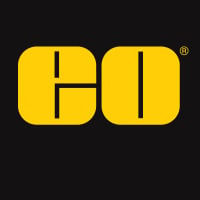 I think this is true for many mid-range and upper-range binoculars that have been publicly evaluated for different center sharpness only with eyes of reviewers.
I think this is true for many mid-range and upper-range binoculars that have been publicly evaluated for different center sharpness only with eyes of reviewers.
Jessie
First, let's imagine a cat in close proximity. The cat ruffles its fur. The "edges" of the cat's body appear washed out, somewhat unsharp, out of focus, due to the visibly ruffled hair. Now we imagine the same cat at a much greater distance, no detail of the hair is visible. The cat's body appears sharp. Are we really judging the sharpness of binoculars correctly?
A short part from the German Wikipedia to shapness in photography:
"The subjective impression of sharpness[edit | edit source].
This sharpness assessment dominates our daily viewing habit. Depending on the specific circumstances (media resolution, image size, viewing distance and time, image message and own expectation) an individual sharpness measure is created.
Example:
...
Sharpness pattern 4: In the center, two versions of a face can be seen. Most viewers describe the right photo as sharper (because it has more contrast).
In the enlargements (outside), it is clear that the left image contains more sharpness. Sharpness and impression of sharpness are two different things.
This kind of sharpness assessment is influenced by a great many subjective things - hence the name subjective sharpness impression."
Sharpness pattern 4: https://de.wikipedia.org/wiki/Schärfe_(Fotografie)#/media/Datei:Schärfemuster4.jpg
Which eye has more "hairs", which eye is sharper? Our impressions (or errors) in somewhat greater distance?
Link with "sharp" pictures and short text in English:
How often are strong contrasts mistaken for excellent sharpness? Strong contrasts are often the enemy of details. Have fun thinking about why low magnification (6x, 7x) binoculars are often perceived to be "very sharp". But sharper (more details) than those with higher magnification?
And good luck for generally valid results within the further discussion whether the Nikon Monarch HG (> 800 Euro/dollars bins) is sharp or not, especially with consideration of the fact that most aberrations occur at the edge of the field of view, affecting light "rays" distant from the optical axis. Many people perceive old soviet porros (BPC5 from KOMC, 30 euro/dollars in ebay, new ~ 80 Deutsche Mark, Made in USSR) very sharp in the sweet spot. Nikon MHGs are > 800 Euro/dollars bins. I'll go get some popcorn ... without mesurement technology (for instance MTF) it's a "dispute over emperor's beard".

Introduction to Modulation Transfer Function
Want to know more about the Modular Transfer Function? Learn about the components, understanding, importance, and characterization of MTF at Edmund Optics.
www.edmundoptics.com
Jessie
Last edited:







